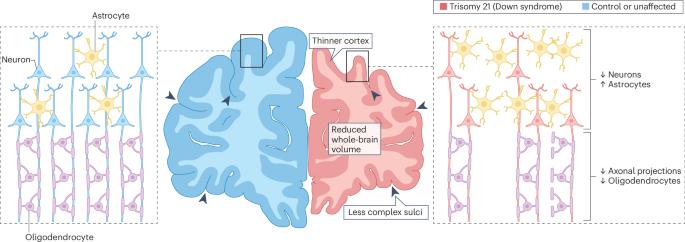Consequences of trisomy 21 for brain development in Down syndrome
IF 26.7
1区 医学
Q1 NEUROSCIENCES
引用次数: 0
Abstract
The appearance of cognitive deficits and altered brain morphology in newborns with Down syndrome (DS) suggests that these features are driven by disruptions at the earliest stages of brain development. Despite its high prevalence and extensively characterized cognitive phenotypes, relatively little is known about the cellular and molecular mechanisms that drive the changes seen in DS. Recent technical advances, such as single-cell omics and the development of induced pluripotent stem cell (iPSC) models of DS, now enable in-depth analyses of the biochemical and molecular drivers of altered brain development in DS. Here, we review the current state of knowledge on brain development in DS, focusing primarily on data from human post-mortem brain tissue. We explore the biological mechanisms that have been proposed to lead to intellectual disability in DS, assess the extent to which data from studies using iPSC models supports these hypotheses, and identify current gaps in the field. Trisomy 21, the genetic cause of Down syndrome, is associated with both cognitive deficits and altered brain structure. Here, Anita Bhattacharyya and colleagues discuss our current understanding of the neurodevelopmental mechanisms that are disrupted in Down syndrome and that underlie these changes.


21 三体综合征对唐氏综合征患者大脑发育的影响
患有唐氏综合征(DS)的新生儿会出现认知障碍和大脑形态改变,这表明这些特征是由大脑发育最早阶段的紊乱所导致的。尽管唐氏综合征发病率高,认知表型特征广泛,但人们对驱动唐氏综合征发生变化的细胞和分子机制却知之甚少。最近的技术进步,如单细胞全息技术和DS诱导多能干细胞(iPSC)模型的开发,使我们能够深入分析DS脑发育改变的生化和分子驱动因素。在此,我们回顾了有关 DS 脑发育的知识现状,主要侧重于来自人类死后脑组织的数据。我们探讨了导致 DS 智障的生物学机制,评估了使用 iPSC 模型的研究数据在多大程度上支持了这些假设,并指出了该领域目前存在的差距。
本文章由计算机程序翻译,如有差异,请以英文原文为准。
求助全文
约1分钟内获得全文
求助全文
来源期刊

Nature Reviews Neuroscience
NEUROSCIENCES-
自引率
0.60%
发文量
104
期刊介绍:
Nature Reviews Neuroscience is a multidisciplinary journal that covers various fields within neuroscience, aiming to offer a comprehensive understanding of the structure and function of the central nervous system. Advances in molecular, developmental, and cognitive neuroscience, facilitated by powerful experimental techniques and theoretical approaches, have made enduring neurobiological questions more accessible. Nature Reviews Neuroscience serves as a reliable and accessible resource, addressing the breadth and depth of modern neuroscience. It acts as an authoritative and engaging reference for scientists interested in all aspects of neuroscience.
 求助内容:
求助内容: 应助结果提醒方式:
应助结果提醒方式:


